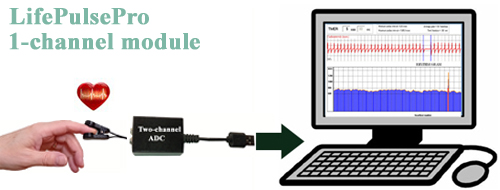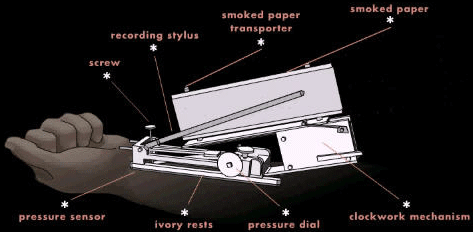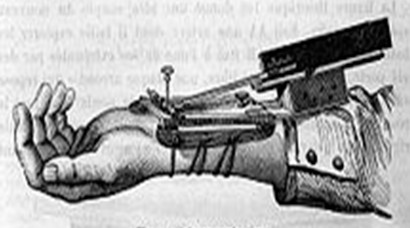Pulse Diagnostics: Heart Rate Variability & Overall Cardiovascular Health & Life Style& Ayurveda
Unveiling Life Pulse Pro's 1-Channel Microprocessor Unit and Specialized Software for Pulse Diagnostics
Embark on a scientific exploration with the integration of an advanced 1-channel microprocessor unit and specialized software within the Life Pulse Pro system.
This 1-channel microprocessor unit, combined with specialized software, unveils a comprehensive analysis of heart rate variability through pulse wave assessment, in perfect harmony with Ayurvedic principles.
Delve into the realm of pulse diagnostics, exploring the polyvagal theory, respiratory tests, pulse patterns, and more. Embrace a novel perspective on evaluating physical and psycho-emotional well-being, where ancient wisdom meets cutting-edge technology.

The heart of Life Pulse Pro lies in its 1-channel microprocessor unit, meticulously designed for scientific accuracy. This unit collaborates effortlessly with the specialized software, creating a synergy that transforms raw data into meaningful health insights. The software, tailored to the microprocessor's capabilities, deciphers the intricate language of pulse waves, allowing for real-time analysis of heart rate variability.
Guided by algorithms designed to decode pulse patterns, it captures the essence of capillary blood flow pulsations with precision. The result is a stream of data that paints a vivid picture of heart rate variability and well-being.
The specialized software is your gateway to unlocking the secrets held within your pulse. Witness the transformation of raw data into visual pulsogramms, each burst representing a heartbeat's journey. The software's real-time capabilities provide instant measurements of time intervals between heartbeats and their amplitudes, revealing the intricate dance of your heart's rhythm.
In adherence to the highest scientific standards, Life Pulse Pro's analysis and processing methods are built upon established methodologies. The specialized software employs a standard mathematical apparatus to assess heart rate variability, ensuring that every insight derived is backed by scientific rigor.
Unveiling the Subtle Rhythms: A Journey into Pulse Insights from Ancient Times
The tangible rhythms that flow beneath our wrists and along our necks grant us priceless insights into our physiological condition. Dating back to antiquity, this inherent phenomenon has ensnared human curiosity, acting as a catalyst for the pursuit of intricate pulse studies.
Early pulse researchers embarked on a quest to capture these vital pulse waves for study, pioneering rudimentary mechanisms for recording. Their ingenuity gave birth to the earliest methods of documenting the pulse's subtle nuances.

In our modern era, diverse instruments and sensors play a role in deciphering the intricacies of the pulse. Electrocardiography, with its utilization of electrical interfaces and the recording of skin bioelectric potentials, has become deeply integrated into contemporary medical practices.
The analysis of electrocardioimpulses propelled initial strides in exploring heart rate variability. This analytical journey enabled the acquisition of cardiointervalograms, histograms showcasing the distribution of cardiointervals, as well as spectral analyses using the Fourier transform on the temporal fluctuations of electrocardioimpulses.
Delving deeper, the study of heart rate variability (HRV) emerges as a robust methodology for health assessment, encompassing both physiological and psychological dimensions. Rooted in the subtle fluctuations of heart cycle duration, HRV is influenced by the intricate interplay of hemodynamics, electrophysiology, and chemical dynamics within the human body.
An HRV indicator rests in the dynamic variations of heart rate over specified time intervals. These intervals, measured in milliseconds, form a canvas for gauging stress regulatory processes. A nuanced decrease in pulse variability within a healthy individual signifies the delicate orchestration of stress modulation.
However, it's essential to acknowledge nuances. Traditional electrocardiography primarily focuses on heart excitation pulses rather than the intricate pulse wave parameters that propagate throughout the body post-electrical stimulation. In contrast, Eastern pulse diagnostics methodologies center around the authentic peripheral pulse wave.
Unlike conventional pulse variability tests reliant on electrocardiography techniques and electrical contacts, the LifePulsePro system pioneers a novel trajectory through the utilization of a photometric pulse sensor. This sensor embodies the heart of our methodology, capturing the intricate parameters of the genuine peripheral pulse wave, rather than focusing solely on the electrical excitation pulses of the heart.
This technique delves into the realms of pulse waves that propagate subsequent to the cessation of electrical excitation impulses. As blood is released into the cardiovascular system, these pulse waves embody a wealth of physiological information. Aligning harmoniously with the core tenets of Oriental medicine, this method offers a holistic perspective.
Crucially, this approach enables the application of a comprehensive mathematical framework, harnessed for assessing heart rate variability through electrocardio monitoring. Beyond this, it furnishes supplementary insights into the dynamic amplitude shifts of the pulse wave, mirroring the body's response to both internal dynamics and external influences.
Guiding us into the future, the LifePulsePro hardware and software bundle presents an innovative approach to health evaluation. Through an intricate analysis of capillary blood pulse waves, this advanced system offers a profound assessment of a patient's well-being. By considering fluctuations in pulse wave amplitude and aligning with Ayurvedic philosophies, it crafts a comprehensive depiction of one's condition.
|
Pulse Diagnostics: Bridging the Polyvagal Theory and Ayurvedic Concepts for Holistic Interpretation
At the heart of the pulse variability test lies a transformative approach, rooted in the polyvagal theory - a profound framework that unveils the intricacies of the vagus nerve's evolutionary journey. This theory serves as a cornerstone for interpreting the outcomes of the pulse variability test, offering a gateway to assess a patient's condition from the vantage point of Ayurvedic principles.
Within the tapestry of the autonomic nervous system, the polyvagal theory introduces a paradigm shift, revealing not two, but three distinct components. Notably, the vagus nerve itself comprises both an ancient unmyelinated segment - the dorsal branch, reminiscent of reptilian heritage - and a more recent myelinated segment - the ventral branch, acquired during the evolution of mammals. These branches stand as gateways to specific adaptive behavioral strategies that play a pivotal role in shaping our physiological responses.
Envisioning this intricate landscape, the heart's function emerges as a symphony conducted by three distinct components. The dorsal system takes center stage, orchestrating the "freeze" mechanism in times of mortal peril or the "digestive" mode during moments devoid of immediate danger, yet suffused with underlying stress. The sympathetic system, a harbinger of fight-or-flight instincts, emerges in stressful scenarios, while also overseeing active pursuits in less distressing contexts. Meanwhile, the ventral system - ever-affable and sociable - encourages a nurturing ethos, transcending external circumstances.
This convergence of the polyvagal theory with the timeless principles of Ayurveda forms the bedrock of our interpretive approach. Through this union, we illuminate a patient's holistic well-being, harmonizing modern scientific understanding with ancient wisdom.
|

|
|
The Architectural Framework of the Singular-Channel Diagnostics System: Unveiling the Pulse Dynamics
Embedded within the nucleus of the singular-channel
pulse diagnostics system resides a architectural construct that intricately exposes the multifaceted cadence of pulse dynamics. This foundation is marked by the pulse sensor, a pivotal nexus that interfaces with the rhythmic signatures of the patient's physiological landscape.
Structurally, this sensor manifests as a harmonious fusion of two components - an ingenious clip housing a photometric sensor. This clip delicately adorns either the earlobe or finger, linking to its counterpart - the analog signal converter. This converter, in turn, orchestrates the transmission of vital data through the USB connector to the computer's domain.
Throughout this orchestration, paramount importance is accorded to preserving the sanctity and reliability of the procured data. A steadfast commitment to stability is epitomized through the sensor's stabilized supply voltage. Moreover, the sensor's unchanging clamping force ensures consistent and dependable data acquisition. Underpinning this reliability, intricate electronic circuitry solutions further fortify the device's precision.

Central to this architecture is the analog signal conversion module. Within its confines, filters harmonize signals, an amplifier bolsters their resonance, and an analog-to-digital converter weaves them into an intricate information stream. This stream journeys through the USB protocol, culminating in a harmonious convergence with the computer's realm.
The device captures the pulse wave's voyage - radiating through the intricate tapestry of the human form, each beat a testament to the body's vibrant functions. It is here that the pulse wave's nuances unfurl, its amplitude and rhythm bearing witness to the pulse's passage and its subsequent influence, weaving through the vascular and tissue network.
With this architecture, our diagnostics system transcends mere measurement, offering an intricate narrative of pulse dynamics. It unlocks the pulsating tale of our physiological symphony, nurturing a deeper understanding of our body's intricate responses.

The proposed 1-channel
pulse diagnostics system, LifePulsePro, not only offers convenience and ease of use but also encompasses a comprehensive spectrum of functionalities. Serving as a beacon of express diagnosis, this system holds the potential to revolutionize the landscape for various stakeholders.
It stands poised to empower human pulse researchers, providing them with a versatile toolset to delve into the intricate realms of pulse dynamics. For practicing medical professionals, including doctors and specialists in the realm of Ayurveda, LifePulsePro emerges as a transformative asset. Its ability to provide swift and accurate insights into a patient's physiological state can augment their diagnostic acumen and therapeutic strategies.
Furthermore, this innovative system extends its reach to encompass those individuals who vigilantly monitor their health. By placing the power of pulse assessment within their grasp, it not only empowers proactive health management but also nurtures a deeper understanding of one's well-being.
An array of functional tests further elevates the system's value proposition. These encompass a Respiratory test that probes pulmonary dynamics, Pulse patterns that uncover nuanced rhythm variations, Orthostatic test to unveil autonomic responses during positional changes, Valsalva's test and Ruffier's test to assess cardiovascular adaptability, BioFeedBack for comprehensive self-regulation, and the identification of symptoms indicative of cardiac autonomic neuropathy.
Ayurveda For You
- Comprehensive website on Ayurveda.
Learn Ayurveda through ebooks, free email courses, free newsletter, Online certificate courses.







 Central to this architecture is the analog signal conversion module. Within its confines, filters harmonize signals, an amplifier bolsters their resonance, and an analog-to-digital converter weaves them into an intricate information stream. This stream journeys through the USB protocol, culminating in a harmonious convergence with the computer's realm.
Central to this architecture is the analog signal conversion module. Within its confines, filters harmonize signals, an amplifier bolsters their resonance, and an analog-to-digital converter weaves them into an intricate information stream. This stream journeys through the USB protocol, culminating in a harmonious convergence with the computer's realm.
